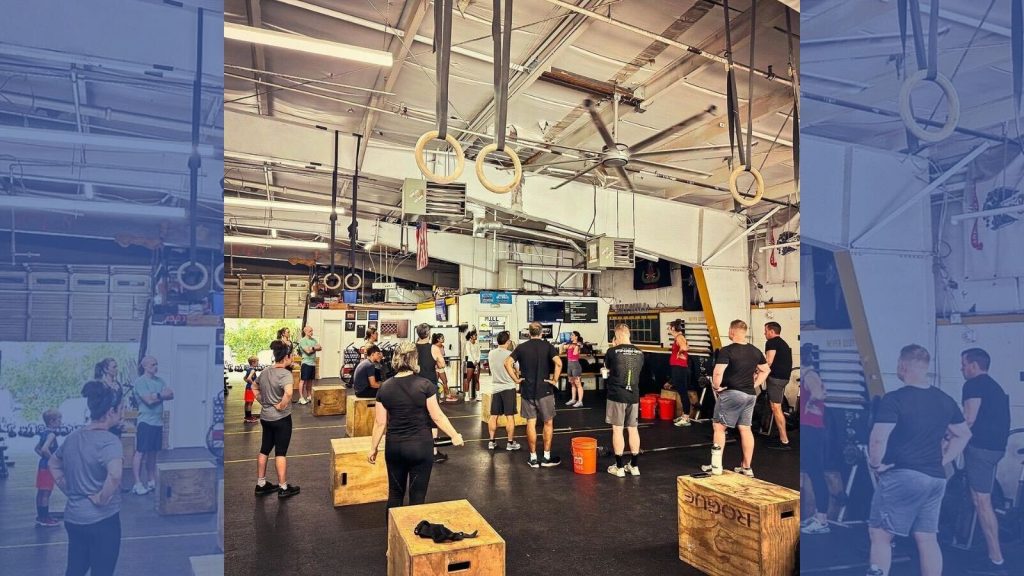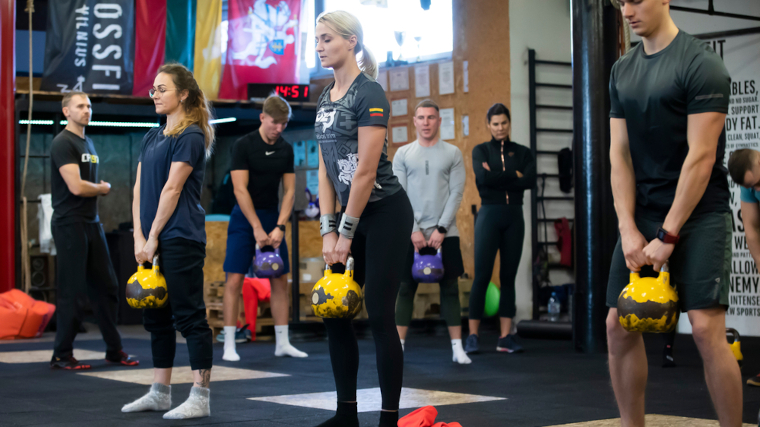In the early days, CrossFit.com was not much more than a leaderboard.
- A “Workout of the Day” was posted every morning, and people were asked to post their scores in the comments.
The leaderboard gained momentum as more people discovered CrossFit. By 2007, founder Greg Glassman decided to host the first in-person CrossFit Competition — the inaugural CrossFit Games — at Dave Castro’s family ranch in Aromas, CA.
It was ultimately a chance for people who had been posting scores on CrossFit.com each day to see how legitimate both they and the other dot-com posters really were.

[Related: Best Barbells for CrossFit]
The Evolution of the CrossFit Leaderboard
As more and more CrossFit affiliates opened in the United States and around the world, the leaderboard continued to play a significant role in CrossFit.
- In the early days, it was usually just an in-house whiteboard where people posted their scores after each class, but eventually, like everything else, it moved online.
First, it was Beyond The Whiteboard, which started in 2007. Today, there are endless apps where gyms house their own internal leaderboard each day.
At its heart, a leaderboard is not just a way for people to see how they stack up against one another — it also makes it easier to monitor progress.
- From an affiliate owner’s perspective, it’s a good thing when people are monitoring progress, as fitness results have long been linked with greater client retention.
But at what point can a leaderboard backfire?
- At what point does it create pressure and anxiety, as people begin to judge themselves based on their placings rather than their personal improvement?
Case in point: You have probably heard of the popular endurance sport tracking app Strava.
If you haven’t, it’s an app mostly for runners, cyclists, and hikers that has more than 125 million registered users, according to the company.
- Strava allows users to track their activity and, essentially, compete against each other on a worldwide platform. Users can follow others, share their workouts and races, and comment on each other’s activities, just like they do on social media.
In theory, Strava is a tool that makes tracking easier and lets people connect.
However, some research shows it can cause anxiety and other negative outcomes.
- Research out of Gustavus Adolphus College in St. Peter, MN, for example, suggests that Strava brings on performance anxiety, insecurities, and social pressure. To boil it down, researchers found that the overarching feeling was: “If it’s not on Strava, it didn’t happen.”
Though this is by no means what every user experiences, some people may feel like they can no longer just run alone for the love of running when using apps like this.
How This Relates to CrossFit
When I started CrossFit, I was a 25-year-old varsity rower.
I was young, I was fit, and I fell in love with CrossFit largely because of the leaderboard and how I was able to measure progress.
- Fast-forward 10 years, and I was a 35-year-old woman with a full-time career, and I no longer wanted to measure myself against others or even against my former self.
I still wanted to do fitness, but I didn’t want to compete every day, let alone feel the anxiety I knew I was going to feel before a workout. Not to mention the guilt I would feel if I (gasp) slacked off one day.

[Related: Best Power Racks for Strength Training]
So, I largely abandoned traditional CrossFit for a few years because I didn’t know there was another way to approach it.
I spent seven years squatting and hinging, pushing and pulling, and conditioning, but I no longer took group classes, hit CrossFit benchmarks, or posted scores on any kind of leaderboard or tracking app.
I grew bored and was only sort of still fit.
Overcoming the Leaderboard
After staying away from classic CrossFit and the anxiety-inducing leaderboard for the better part of seven years, I returned to CrossFit last spring (with more maturity this time).
I’m back doing classes, back doing the workout of the day, and back doing whatever benchmarks my gym — Kea Athletics in Surrey, BC — programs for me.
- Having taken so much time away, I’m finally able to let my ego aside and not care about my scores. (Well, sometimes, in the moment, I care for half a minute, but then I can let it go).
Sometimes, I choose to scale the workout; other days, I choose to go hard.
It depends on the day, but I listen to my body and my mind, which always tells me what it thinks it’s capable of that day.
That being said, it took me stepping away from what I call real CrossFit for seven years to get back to this place where I’m excited to go to the gym again.
What Gym Owners Are Saying
In a survey on the Affiliate Owner’s Group on Facebook, 57 out of 72 gyms that responded said they still use a leaderboard at their gym.
Those who have moved away from the leaderboard said things like the leaderboard led to too many cheaters “just to be on top.”
- “The second we dropped [the leaderboard], people started lifting heavier. Everyone’s numbers went way up. Way better experience without it. Also, it allowed for more time for the coaches to coach instead of writing names and numbers down on a board,” David Israel, the owner of CrossFit Felix in Seattle, WA, said.
The majority of people who still use a leaderboard today said they roll it out more carefully to their communities than they did in the pre-2015 days.
- Marco Tan, the 15-year gym owner of CrossFit Overdrive in Richmond, BC, no longer has a visual leaderboard on the whiteboard in the gym, but members are able to track their results in an app.
More important than that, though, is that he deliberately promotes and actively preaches “training and not competing on a daily basis.”
- “The scores [in the app] are simply journal entries for the coach to look at and see how they’re clients are doing,” Tan added.
The same is true for Danielle Ullmann, the 10-year owner of CrossFit West Seattle in Seattle, WA.
She still uses Wodify’s leaderboard, but she has created a culture that has become mostly a place for “friendly banter.”
- She added: “Our members love it. It’s not used in a competitive sense, but that’s also not the vibe at our gym.”
Further, Avery Jesmer of CrossFit Ravage in Medford, OR, said her gym writes names only, not scores, on its whiteboard simply to celebrate people’s attendance.
People can use SugarWOD if they want to log their scores, but it’s mostly just a way to record and track their progress over time.
- “When we opened our affiliate, we [decided we] weren’t going to write scores on the board,” Jesmer said. “I remember at past affiliates how uncomfortable it would make some people to have their score written up, so the app allows it to be optional and doesn’t draw attention to people who are newer in their journey or who feel self-conscious about scaling or otherwise. The pressure of the whiteboard, more than the optional app, I think is what drives people to manipulate scores.”
Lisa Fafard, the owner of CrossFit Novus in Yorkton, Saskatchewan, takes a similar approach.
Her gym doesn’t write names or scores on the whiteboard after class, but everyone still has the
opportunity to log their scores in an app.
- “This still fosters community via comments, engagement, encouragement, [and] fun, while saving our coaches so much time,” she said.
One Big Thing
Nicole Carroll, CrossFit’s Director of Training and Certification, recently discussed the leaderboard in CrossFit on the new CrossFit Training YouTube Channel. She said it’s a missed opportunity when gyms stop posting scores on the whiteboard to protect people’s feelings.
While it is a place to post scores, she says it’s also a place to gather and really feel a “sense of community.”
- “There can be weird associations with [the whiteboard], but [what it’s supposed to do is] provide an incredible opportunity for people to come together, for the coach to bring people together, and what really matters is what you had in you that day, and sharing it, and each person in the class kind of making themselves vulnerable enough to share that score,” she said.
A Message From a CrossFit Games Athlete
Although a gym owner can promote and preach a certain culture, it still comes down to the individual. Often, those who have the most trouble with leaderboard anxiety are those who are used to seeing themselves at the top.
Four-time CrossFit Games athlete Mekenzie Riley, who was fifth at the 2024 Masters CrossFit Games in the women’s 35-39-year-old division, started CrossFit in 20212 and said she “absolutely loved competing and putting my score on the whiteboard.”
[Related: Best Adjustable Dumbbells]
Today, however, as a mother of two children, she often modifies workouts and has found a way to be less focused on her numbers.
- “My willingness to visit the pain cave has diminished immensely, so most every workout is done with relative control and composure,” Riley said.
She added: “I look at my kids and it makes it easy to accept that I may never be at my peak fitness again and that’s OK. I have so much more in life that takes the time and energy that it would take to be that fit ever again. I’m okay with that, and I can still be pretty fit and strong and do cool gymnastics, even if it’s not personal PR level.”
To those struggling to let go of what they used to be or to those who experience leaderboard or performance anxiety that’s taking away from their experience at the gym, Riley offered this:
- “Ask yourself, ‘What does this number change for you at the end of the day?’ Or in five years, ‘What does this number matter for you?’ If the answer is nothing, then remember why you like doing this stuff. You’re healthier, and it’s fun, and you build community. Those things will matter in a decade,” she said.
The Big Picture: The CrossFit Leaderboard is Alive and Well
The leaderboard undoubtedly can spur on anxiety, insecurities, and pressure, but it doesn’t have to.
- What CrossFit has that a fitness tracker doesn’t are coaches and gym owners who can create a positive culture around the leaderboard.
It certainly has made a difference for me.
It might sound corny, but my gym owners always give us a chance for a smiley-face option instead of a numerical score at the end of the class.
Some days, my scores are written on the whiteboard after class — other days, I give myself a smiley face and remind myself that sometimes it’s actually OK to slack off.
More From CrossFit
- Dana Paran Surprises Herself, Qualifies for 2024 Rogue Invitational
- 2024 Dubai Fitness Championship Roster: Luka Ðukić Returns to Competition
- Celebrating the 2024 Rogue Invitational Legends Roster
Featured image: @welcome_to_the_mill / Instagram
The post The CrossFit Leaderboard – Source of Anxiety or Value Add for Your Community? appeared first on BarBend.
from BarBend https://ift.tt/NGpoLsZ
via IFTTT
 (@itskenzieriley)
(@itskenzieriley)
Comments
Post a Comment